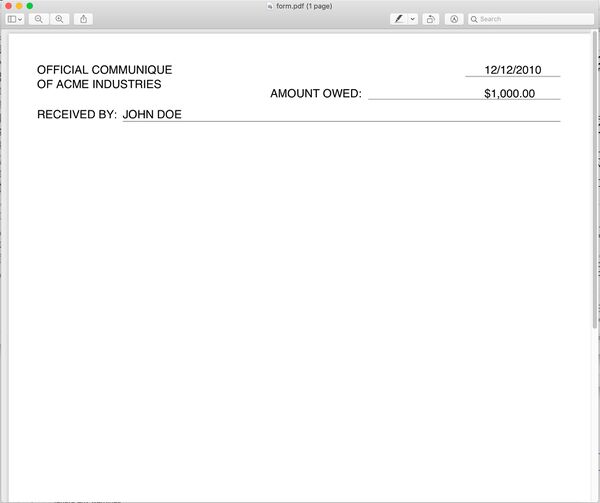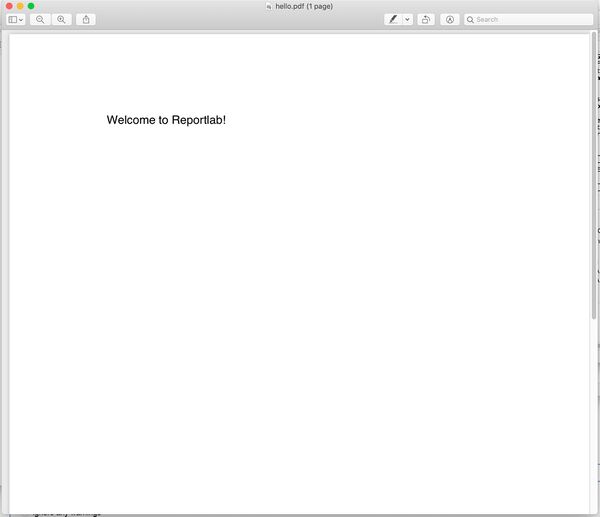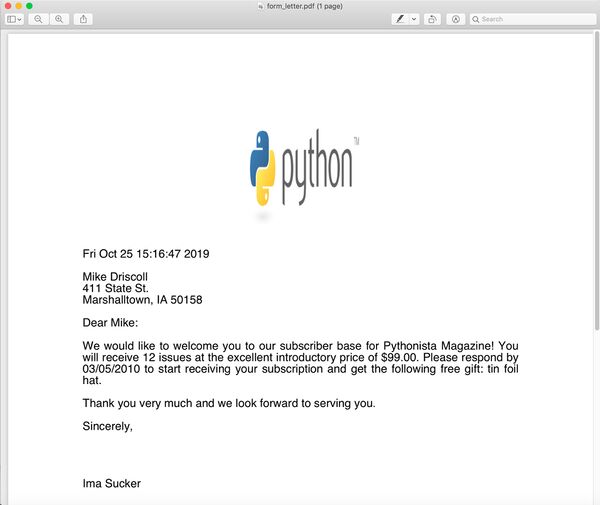User:Simon/Trim4/Layout using Reportlab: Difference between revisions
No edit summary |
No edit summary |
||
| Line 62: | Line 62: | ||
canvas.save()</nowiki> | canvas.save()</nowiki> | ||
The main difference here is the canvas.line function - which draws lines on the canvas. | The main difference here is the canvas.line function - which draws lines on the canvas. Passing it two X,Y pairs sets the coordinates for where each line should begin and end.<br> | ||
[[File:reportlab_form.JPG|600px|frameless]] | [[File:reportlab_form.JPG|600px|frameless]] | ||
Latest revision as of 15:10, 27 October 2019
Reportlab is a Python library that allows you to make multi-page documents, working with a canvas. I found a nice introduction and tutorial here: https://www.blog.pythonlibrary.org/2010/03/08/a-simple-step-by-step-reportlab-tutorial/
From this tutorial, I created a basic page:
#import the canvas object from pdfgen
from reportlab.pdfgen import canvas
#supply a filename to the canvas object
c = canvas.Canvas("hello.pdf")
# drawstring draws text - starts at the bottom left, so this is 100 points (pixels) from the left margin, and 750 from the bottom
c.drawString(100,750,"Welcome to Reportlab!")
#save the PDF
c.save()
By adding a zero to the bottomup keyword argument you can change where drawstring starts drawing text from - this will probably set it to begin at top left The default canvas is A4, this can be changed to other formats (such as US letter) with the following code:
#import the letter format from the pagesizes library
from reportlab.lib.pagesizes import letter
#import the canvas object from pdfgen
from reportlab.pdfgen import canvas
#supply a filename to the canvas object, specify the pagesize to be letter
canvas = canvas.Canvas('myfile.pdf', pagesize=letter)
#grab the width and height for letter - this can be useful to calculate when to add a page break or to define margins
width, height = letter
Other options for the canvas object:
def __init__(self,filename,
pagesize=letter,
bottomup = 1,
pageCompression=0,
encoding=rl_config.defaultEncoding,
verbosity=0
encrypt=None):
A form:
from reportlab.lib.pagesizes import letter
from reportlab.pdfgen import canvas
canvas = canvas.Canvas("form.pdf", pagesize=letter)
canvas.setLineWidth(.3)
canvas.setFont('Helvetica', 12)
canvas.drawString(30,750,'OFFICIAL COMMUNIQUE')
canvas.drawString(30,735,'OF ACME INDUSTRIES')
canvas.drawString(500,750,"12/12/2010")
canvas.line(480,747,580,747)
canvas.drawString(275,725,'AMOUNT OWED:')
canvas.drawString(500,725,"$1,000.00")
canvas.line(378,723,580,723)
canvas.drawString(30,703,'RECEIVED BY:')
canvas.line(120,700,580,700)
canvas.drawString(120,703,"JOHN DOE")
canvas.save()
The main difference here is the canvas.line function - which draws lines on the canvas. Passing it two X,Y pairs sets the coordinates for where each line should begin and end.

and a letter with flowing text:
import time
from reportlab.lib.enums import TA_JUSTIFY
from reportlab.lib.pagesizes import letter
from reportlab.platypus import SimpleDocTemplate, Paragraph, Spacer, Image
from reportlab.lib.styles import getSampleStyleSheet, ParagraphStyle
from reportlab.lib.units import inch
doc = SimpleDocTemplate("form_letter.pdf",pagesize=letter,
rightMargin=72,leftMargin=72,
topMargin=72,bottomMargin=18)
Story=[]
logo = "python_logo.png"
magName = "Pythonista"
issueNum = 12
subPrice = "99.00"
limitedDate = "03/05/2010"
freeGift = "tin foil hat"
formatted_time = time.ctime()
full_name = "Mike Driscoll"
address_parts = ["411 State St.", "Marshalltown, IA 50158"]
im = Image(logo, 2*inch, 2*inch)
Story.append(im)
styles=getSampleStyleSheet()
styles.add(ParagraphStyle(name='Justify', alignment=TA_JUSTIFY))
ptext = '<font size=12>%s</font>' % formatted_time
Story.append(Paragraph(ptext, styles["Normal"]))
Story.append(Spacer(1, 12))
# Create return address
ptext = '<font size=12>%s</font>' % full_name
Story.append(Paragraph(ptext, styles["Normal"]))
for part in address_parts:
ptext = '<font size=12>%s</font>' % part.strip()
Story.append(Paragraph(ptext, styles["Normal"]))
Story.append(Spacer(1, 12))
ptext = '<font size=12>Dear %s:</font>' % full_name.split()[0].strip()
Story.append(Paragraph(ptext, styles["Normal"]))
Story.append(Spacer(1, 12))
ptext = '<font size=12>We would like to welcome you to our subscriber base for %s Magazine! \
You will receive %s issues at the excellent introductory price of $%s. Please respond by\
%s to start receiving your subscription and get the following free gift: %s.</font>' % (magName,
issueNum,
subPrice,
limitedDate,
freeGift)
Story.append(Paragraph(ptext, styles["Justify"]))
Story.append(Spacer(1, 12))
ptext = '<font size=12>Thank you very much and we look forward to serving you.</font>'
Story.append(Paragraph(ptext, styles["Justify"]))
Story.append(Spacer(1, 12))
ptext = '<font size=12>Sincerely,</font>'
Story.append(Paragraph(ptext, styles["Normal"]))
Story.append(Spacer(1, 48))
ptext = '<font size=12>Ima Sucker</font>'
Story.append(Paragraph(ptext, styles["Normal"]))
Story.append(Spacer(1, 12))
doc.build(Story)


